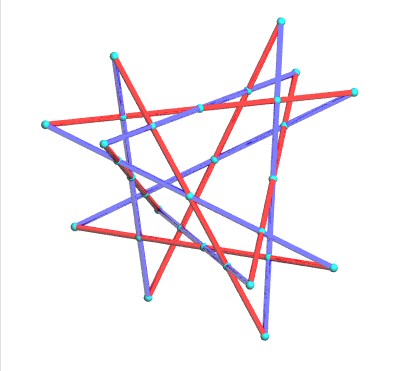

 |
 |
| Ludwig Schläfli (1814-1895): Swiss mathematician. |
A double six is a set of 12 lines in the 3-dimensional projective space, often written, the notation being due to Schläfli, as a matrix:
The number 6 is the maximal value of n such that a set of 2n lines can have this property (proof of this fact).
To construct a double six, we can start from a line with 5 secants
such than none of them is included in the quadric generated by 3 of the 4 other lines.
Four lines among the 5 secants admit
as a common secant and also have another common secant: if {i,
j, k, l, m}={1, 2, 3, 4, 5}, write
the common secant to
different from
; it can be proved that
does not intersect with
: to finish this double six, we just need the line
: common secant to
that does not intersect with
: the (difficult) double six theorem states that such a line exists.
Every line of the double six cuts exactly 5 others; therefore, there are intersection points
in the double six.
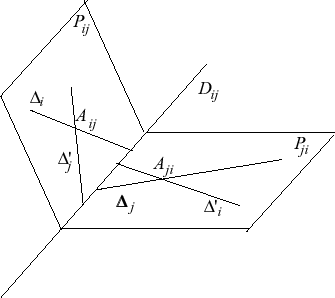 |
The 30 pairs of secant lines |
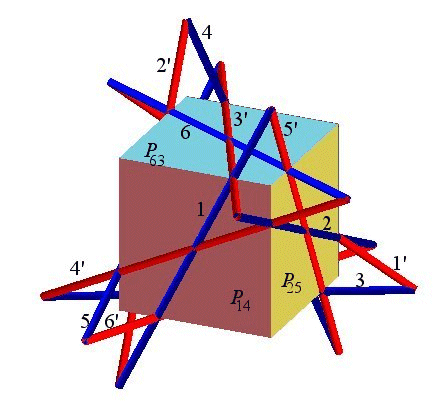 |
Figure of the double six with the six lines Every red line cuts exactly 5 blue lines and vice versa. This affine view was chosen in order for the 6 planes
This way, the 3 lines
|
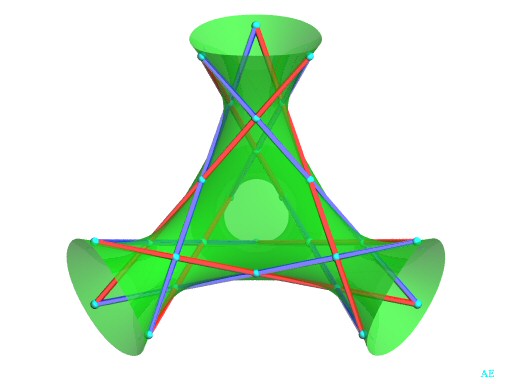 |
There exists a unique smooth cubic surface (S) containing the 12 lines of the double six.
For the double six represented above, where the vertices of the chosen cube are
|
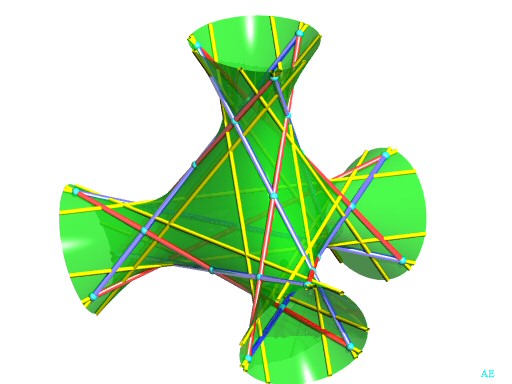 |
The 27 lines of this cubic are the 12 lines of the double six (in red and blue opposite) plus the 15 lines (but remember that in the representation opposite, the 3 lines |
The figure composed of the 27 lines is called eikosiheptagram (eikosihepta = 27 in Greek).
In this setting, every line intersects with exactly ten others:
- every yellow line is secant to the 4 red and blue lines
and with the
yellow lines
for
(proof of this fact).
- every red line is secant to the 5 blue lines
and the 5 yellow lines
.
Therefore, there exist pairs of non secant lines.
It can be proved that there exist, in the eikosiheptagram, exactly 36 double sixes:
- the initial double six N.
- the double sixes of the type
, qualified as "syzygetic" to N
- the double sixes of the type
, qualified as "azygetic" to N.
The group of the permutations of the 27 lines that respect the incidences of the lines therefore has 6 ! . 2 . 36 = 51 840 elements; it is isomorphic to the Weyl group W(E6) and its subgroup of even permutations is isomorphic to the symplectic projective group PSp4(F3) which is not simple.
Each of the 30 plans contains 3 lines of the surface (S) (
and
): they are called tritangent planes (since they are tangent to the surface at 3 points).
But there exist other tritangent planes, coming from the above double sixes, generated by the 15 trios of two by two secant lines
; it can be proved that these 45 tritangent planes are the only ones: every line is common to 5 tritangent planes.
The incidences of the various elements of the eikosiheptagram are summarized in the table below:
| ....intersections | points | lines | tritangent planes | double six | eikosiheptagram |
| each point... | 1 | 2 | 1 | 8 | 1 |
| each line... | 10 | 10 | 5 | 16 | 1 |
| each tritangent plane... | 3 | 3 | 15 | 36 | 1 |
| each double six... | 30 | 12 | 45 | 36 | 1 |
| the eikosiheptagram... | 135 | 27 | 45 | 36 | 1 |
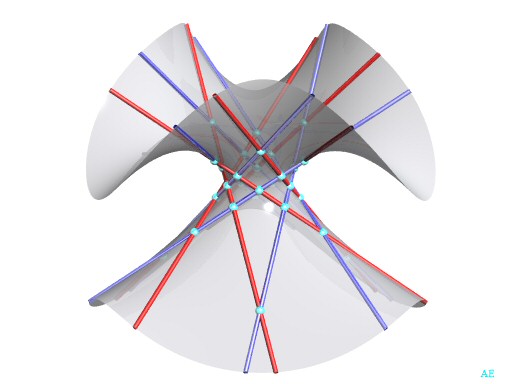 |
Here is a view of the principal double six of the Clebsch surface. |
| This only appears to be a double six: every blue line intersects with 5 red lines, but also the sixth, at infinity!
In a true double six, there cannot be more than 3 lines of each family on a same quadric (see this figure) |
| WEBOGRAPHY
Java applet for the double six, on the same website: enriques.mathematik.uni-mainz.de/cubicsurface/background/background_frame.php3?shortname=doublesix Rod model for the double six: www.math.arizona.edu/~models/Wire_models/source/2.html |
© Robert FERRÉOL , Alain ESCULIER 2017